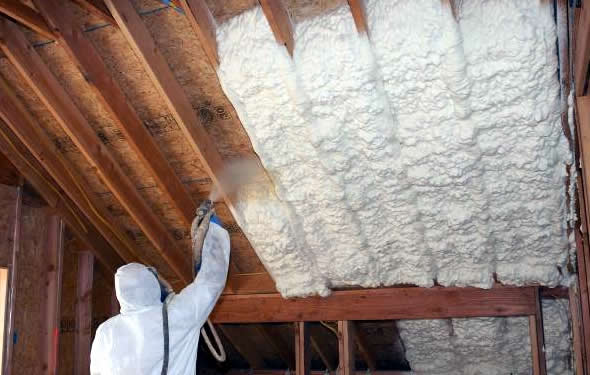
Last week, in How Stuff Flows, we discussed the natural flow of liquid, air, moisture and heat around buildings.
This week we are going to discuss some of the benefits of Unvented Attics.
The 2012 IRC Section 806.5 allows for Unvented Attic and Unvented Enclosed Rafter Assemblies and offers several parameters for creating these designs, including the use of an air impermeable insulation, like spray foam, applied directly to the roof deck. When you use this design parameter, the conventional building envelope is changing. You are moving the thermal boundary from the ceiling plane to the underside of the roof deck and encapsulating the traditional attic space within the newly designed thermal envelope. Surprisingly, this “new age” concept of eliminating “traditional” ventilation from attics dates back more than 30 years to the mid-1980’s. These assemblies have shown excellent performance characteristics over the years, by changing the thermal boundary and achieving some very important benefits:
- Moving the HVAC system, the air handler and ductwork, into the thermal envelope, and therefore conditioned space
- Eliminating heat and moisture loads associated with “traditional” ventilation caused by unwanted air infiltration entering the structure through the attic
- And, protecting the attic from exterior contaminants
The building industry has known for years that placing the HVAC system inside the thermal envelope is very beneficial for a number of reasons. First of all, lowering the ambient temperature surrounding the HVAC system lowers the operating stress on the equipment, and by lowering the delta T, or temperature difference, across the air handler and the ductwork, the system will be more efficient. Furthermore, ALL DUCTS LEAK; and this duct leakage will now be maintained inside the thermal envelope, once again increasing the overall efficiency of the system.
Now, these attics are “semi-conditioned”, due to:
- Passive interconnection between the living space and the attic through the ceiling membrane
- Internal convection currents created by the inherent temperature difference between the living space and the attic
- And, duct leakage that is now maintained within the newly created thermal envelope.
So rather than having a 120˚F+ attic applying a heat and moisture load above the living space, attic temperatures are typically within 8 to 12 degrees of the living space, or approximately 85˚F and 90˚F at the hottest part of the day.
Stay tuned next week as we continue to discuss the interesting world of spray foam insulation.
Subscribe here to keep in touch with Spray Foam Advisor and get your FREE copy of 25 SPF Frequently Asked Questions and a PRIVATE link to Robert Naini’s SPFA Breakout Session, “3 Ways to Close More Sales with Building Science.”


